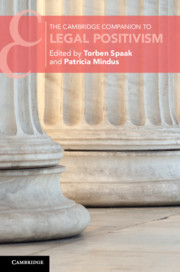Book contents
- The Cambridge Companion to Legal Positivism
- Cambridge Companions to Law
- The Cambridge Companion to Legal Positivism
- Copyright page
- Contents
- Figures
- Contributors
- Acknowledgements
- 1 Introduction
- Part I Fundamentals
- Part II History
- Part III Central Figures
- Part IV Main Tenets
- Part V Normativity and Values
- Part VI Critique
- 27 Gustav Radbruch’s Critique of Legal Positivism
- 28 Good Order and Workable Arrangements: Lon Fuller’s Critique of Legal Positivism
- 29 Dworkin’s Critique of Hart’s Positivism
- 30 Tracing Finnis’s Criticism of Hart’s Internal Point of View: Instability and the ‘Point’ of Human Action in Law
- 31 Alexy’s Critique of Legal Positivism
- 32 Mark Greenberg on Legal Positivism
- 33 Positivism and Totalitarianism
- Index
- References
29 - Dworkin’s Critique of Hart’s Positivism
from Part VI - Critique
Published online by Cambridge University Press: 21 January 2021
- The Cambridge Companion to Legal Positivism
- Cambridge Companions to Law
- The Cambridge Companion to Legal Positivism
- Copyright page
- Contents
- Figures
- Contributors
- Acknowledgements
- 1 Introduction
- Part I Fundamentals
- Part II History
- Part III Central Figures
- Part IV Main Tenets
- Part V Normativity and Values
- Part VI Critique
- 27 Gustav Radbruch’s Critique of Legal Positivism
- 28 Good Order and Workable Arrangements: Lon Fuller’s Critique of Legal Positivism
- 29 Dworkin’s Critique of Hart’s Positivism
- 30 Tracing Finnis’s Criticism of Hart’s Internal Point of View: Instability and the ‘Point’ of Human Action in Law
- 31 Alexy’s Critique of Legal Positivism
- 32 Mark Greenberg on Legal Positivism
- 33 Positivism and Totalitarianism
- Index
- References
Summary
Patterson argues that Dworkin’s critique of legal positivism, specifically Dworkin’s critique of Hart’s positivist theory of law, went through two stages: first the critique put forward in Dworkin’s 1967 article ‘The Model of Rules’, which focused on the alleged inability of the rule of recognition to account for the existence of legal principles; then the criticism expressed in Law’s Empire concerning the alleged inability of the theory to account for the existence of so-called theoretical disagreement in law. Patterson’s conclusion, however, is that although Dworkin in his mature critique made a number of valid points, such as identifying the lack of a thought-out view on legal interpretation in Hart’s legal philosophy, he ultimately failed to undermine Hart’s theory. As Patterson sees it, although legal positivists lack a thought-out view of legal interpretation, there is nothing in the theory of legal positivism that stops them from developing such a theory, and he suggests three crucial criteria that a positivist theory of legal interpretation must satisfy, namely, minimal mutilation of existing law, coherence, and generality.
- Type
- Chapter
- Information
- The Cambridge Companion to Legal Positivism , pp. 675 - 694Publisher: Cambridge University PressPrint publication year: 2021
References
- 1
- Cited by

